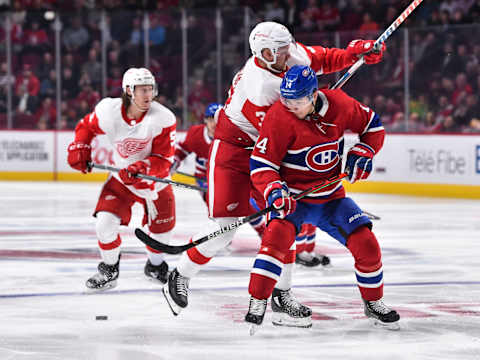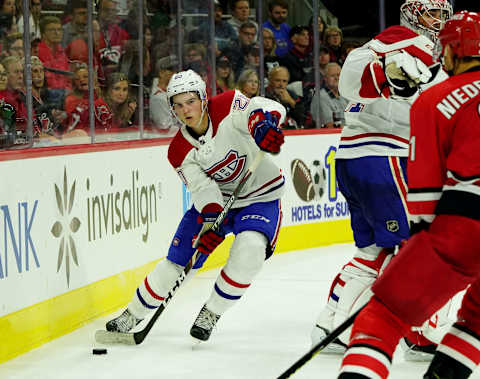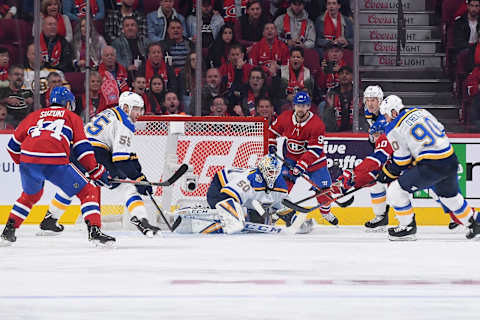Montreal Canadiens: What do the stats say of Nick Suzuki and Cale Fleury?


Nick Suzuki and Cale Fleury have seemed to the depths of the Montreal Canadiens priority list, and their numbers can provide insight on how that can change.
The Montreal Canadiens are entering their second week of full NHL duties, and two aspects of the team are truly different. Ahead of the season opener, the fan base was ecstatic that both Nick Suzuki and Cale Fleury won a spot on the roster out of camp. Suzuki earned a seat on the right of Max Domi while Fleury was in charge of manning the bottom defence pair with Brett Kulak by his side.
Things aren’t as positive as they were back then. Fleury has missed the last three games as a healthy scratch while Suzuki has found himself on the fourth line once or twice. The lines at practice on Monday were even more telling of the 2017 first-round pick’s situation. Suzuki was alternating at centre with Jesperi Kotkaniemi while Nick Cousins was fully participating as the fourth line’s right-winger.
Suzuki may find himself healthy scratched as well if Cousins is good to go against the Tampa Bay Lightning. Should they?
Julien hasn’t been shy to scratch a developing player as Victor Mete watched some games from the press box in his rookie year while Kotkaniemi was taken out one night on the West Coast.
Obviously, there are things both Suzuki and Fleury are doing that aren’t sitting well with the coaching staff. The latter’s stand out a bit more playing on defence, but Suzuki has had his blunders as well. Off the top of my mind, the Trevor Moore strip against the Toronto Maple Leafs wasn’t one of his finest moments.
The 20-year-old does have a point on the season getting a helper on Joel Armia‘s offensive outbursts in Buffalo. But what else are the numbers saying about Suzuki and Fleury? And of course, I don’t mean the raw numbers here, what are the advanced stats saying of how either is fairing in their NHL careers so far?

Let’s first focus on what the Montreal Canadiens should want from either (advanced-wise) starting with Fleury.
Playing on the bottom pair is, in some ways, similar to being a forward on the fourth line. Your job is to be present, spend as little time as possible in your own zone, and refrain from taking penalties and giving up high-danger chances in your own end. Fleury has always been known for being an “offence-first defenceman” but has rounded out his game after a year under Joël Bouchard in Laval. That said, his defensive awareness was a point of interest, and he showed growth in that department at training camp.
More from Analysis
- Canadiens: Revisiting the Ben Chiarot Trade Following the 2023 Draft
- Canadiens: Analytical Model Isn’t High on the Habs
- Canadiens: NHL Schedule Finally Rights A Wrong
- Canadiens: Bad Contracts Were Bergevin’s Parting Gift for Kent Hughes
- Montreal Canadiens: A Brief Look at the 2024 NHL Entry Draft
To look at how well Fleury suppresses shots, we’ll look at his RelCA/60, which shows the number of scoring attempts allowed when he’s on the ice vs. off the ice. The lower the number, the better while it’s counterpart, shots generated – RelCF/60, is better the higher it is.
Fleury has a RelCA/60 of 14.37 and a RelCF/60 of -22.75 at 5v5. This means he is spending most of the time trying to defend rather than advance the puck and create chances, and when he does, it’s not very useful. Overall, the 20-year-old isn’t driving possession or limiting attempts made by the opposition, which stands out like a sore thumb.
Kulak has been better defensively with a RelCA/60 of -4.53. His offence isn’t saying much, but Julien isn’t really looking at that area of the game when you’re on the bottom pair despite the fact that it can be an asset. That said, Kulak has the ability to play higher in the lineup and will improve as the year goes on.

Suzuki is a different story. He’s spent the majority of his time in the top six with Domi and Artturi Lehkonen before being bumped down to play with Nate Thompson and Paul Byron. In the top-six, you’re expected to not only be responsible defensively but to generate offence, and when dealing with Julien as a coach, the latter needs to take precedent despite playing the easier position.
Suzuki has a total of three shots on goal, four scoring chances, and one high-danger scoring chance in his five games this season. When looking further, he isn’t getting much going possession-wise with a 46% Corsi-for while his expected goals are approximately one. His low expected goals speak not only to the number of shots taken but the area of them. There is not much danger or urgency here.
His shot generation numbers are what you’d expect at -15.84. However, playing with Domi and Lehkonen can attest to that as both are players who shoot the puck as much as possible and get the most touches as a line. What is reassuring is his shot suppression, which is at a 0.48, a fair value at this stage.
Keep in mind that he wasn’t only playing in the top six. When on the fourth line, Suzuki’s shot attempts against may have decreased – a positive sign in Julien’s eyes – but his ability to create offence did as well.
Another thing that doesn’t look too good is how badly Suzuki is getting hit.
A couple of #Habs forward stats after 5 games:
— Alex Nyko (@AlexNyko) October 13, 2019
1- Domi & Armia bleed turnovers
2- Byron the one with positive takeaways
3- Armia & Kotkaniemi are hitting machines (Lehk & Phil not far behind too).
4- Suzuki is a prime hit target. pic.twitter.com/l5UHYpmYiO
Being able to put yourself in safe areas is a skill developed over the years in the NHL. Suzuki isn’t the biggest body, and this isn’t to say he won’t be able to thrive in the big leagues, but he does need to add more muscle and be aware of his surroundings. Hits were something Taylor Hall experience a lot in the first few years of his career, but he gained the knowledge of how to work around it over time.

Fleury needs more games played to get a better picture of what he’s capable of, but so far, this is what he’s shown. If Julien doesn’t trust him to put him in a Montreal Canadiens game, the organization is better off sending him down to play for the Laval Rocket.
Defenceman of his age needs reps and playing time to perfect his craft, and he won’t learn anything by watching in the press box and practicing. The Habs have enough depth to cover his spot, and it looks as if Christian Folin and Mike Reilly are eager to stick in the lineup. There’s also the case of Noah Juulsen, who is healthy and will want to be back with the Montreal Canadiens as soon as possible.
Personally, I’m not a fan of playing a top prospect on the fourth line, but he’s not necessarily playing with “fourth-line players.” Thompson has his role, but Byron is capable of playing in the top-nine and has a speed that can compliment Suzuki well. Sometimes throwing a player on the fourth line can do them some good in the long run. It’s when it becomes a chronic assignment where things get messy.
Suzuki needs to focus on getting more shots on net, and if he remains on the fourth line, he’ll be free to carry the puck more, which is an asset of his. The problem is that he has to take care to not turn the puck over when doing so. He has to stick to his role, but that doesn’t mean he can’t let some of his skills come out.
Next. Brett Kulak Should be on the Top Pair. dark
The Montreal Canadiens have two fantastic players in their midst, and it’s conversations like these that prove development is a marathon and not a sprint. Suzuki and Fleury both have their individual lessons, and as long as they acknowledge what they’re doing wrong and work to improve them, there’s no telling where they’ll go.
Advanced Stats from Natural Stat Trick.